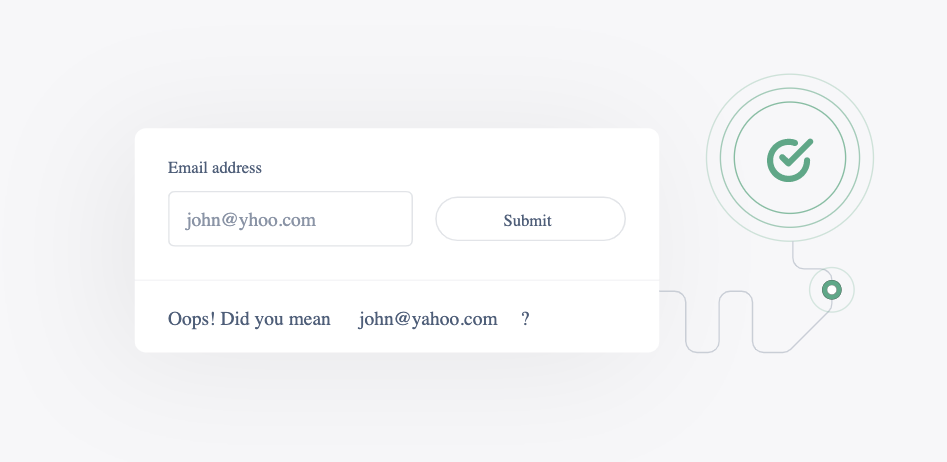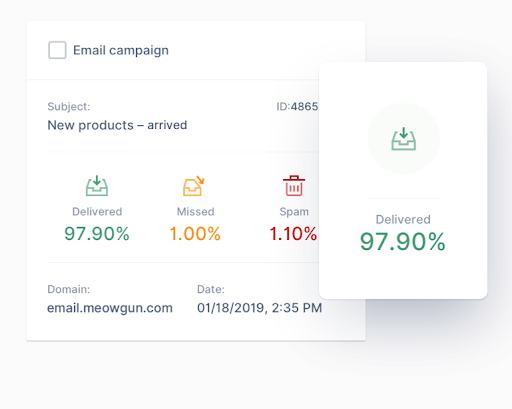Deliverability
How to build an email list the right way
Building an email list? We've got tips for the best collection practices (and tips on what to avoid). Read more...
PUBLISHED ON
We’ve seen a lot of lists – good lists, bad lists, ugly lists, and everything in between – so we can usually tell when a company’s email list is going to cause deliverability problems.
When someone says, “Yeah, I know how to collect email addresses. I’ve got about ten million people on my list. I bought it off the internet a few years ago from a guy named Joe, and…” that raises some red flags (okay, a lot of red flags).
Look, we know list collection might sound less cool than other email topics. It’s really, really tempting to focus only on the ways you can get more potential customers and a long email list no matter what. But no matter how big your list is, unless your contacts gave you consent to email them, you won’t see great results. Plus, your email service provider (ESP) will get mad at you, and that’s no fun.
Let’s take a look at what consent is and how you can use it to build a healthy email list. Ready? Let’s go.
Table of contents
Single opt-in
Single opt-in with email
Double opt-in
Validating your emails
Being transparent
Giving your customers options
Keeping incentives to a minimum
Creating high-quality content
Purchasing or renting lists
Email appending
Scraping your list
Only getting implied consent
What is user consent?
Consent is a requirement based on our Acceptable Use Policy. And it’s not just us – you’ll find that every ESP worth their salt requires it as well. There’s a good reason for this: Many countries and regions have created laws to protect consumer consent and require brand communication and data transparency. Some of the most important consent laws include the American CAN-SPAM Act, the European General Data Protection Regulation (GDPR), and the California Consumer Privacy Act (CCPA).
By consent, we mean that the people on your list gave you permission to contact them in a specific way about specific things, like updates and those almighty discounts. This permission is vital for being able to send messages to subscribers and to protect yourself and them against malicious content and sending actions.
So, how do you get permission during your list collection process? Give your visitors and customers a way to securely and definitively opt into your list. There are three main types of opting in, one of which we personally recommend for best results.
Single opt-in
Single opt-in means the user simply submits their email address through a signup form, and they’re immediately added to the list. Easy.
Single opt-in with email
With this option, a user opts in through a signup form and then receives an email that confirms they’ve been added to the list. Slightly less easy, but more effective.
Double opt-in
Double opt-in (as its name implies) requires an additional step. Once the user has signed up through a form, they receive an email with a link. The user must open the email and click the link in order to verify their email address and confirm that they want emails from you.
At Sinch Mailgun, we highly recommend double opt-in because it’ll give you the highest quality list possible. Yes, it’s more work than single opt-in, but it means you’ve got a list full of engaged users with real email addresses. These users are way more likely to actually interact with your messages and not ignore you or mark you as spam.
Best practices for list collection
Beyond opt-in, there are a few other recommended list-building strategies that will ensure you have a great email list made from your target audience and everyone else who really wants to hear from you.
Validating your emails
Validating users’ email addresses during the signup process keeps you from having a lot of nonexistent or spammy addresses on your list, plus it can catch users who may have misspelled “gmail” while signing up (you know you’ve done it yourself). Mailgun’s email verification API can easily be implemented into forms to prevent typos, disposable addresses, role-based email addresses, and more. You can learn more about it and sign up here.

Being transparent
Make it clear to the user what exactly it is that they’re signing up for. If submitting their email address will subscribe them to your blog, make sure that’s obvious. For even more transparency and happier users, indicate the frequency of your sending so they know what to expect. (And, speaking of blog subscriptions, you can subscribe to our blog for more updates on email best practices.)
Also, make sure you have an unsubscribe button visible in each of your emails. While it may seem counterproductive to your list-building goals, giving users the option to unsubscribe will help your list clean itself of unengaged recipients. This means you’ll get a lot less deliverability-hindering stuff like spam reports and mass ignores.
Giving your customers options
Have you ever been on a list that emails you all the time? You like them, but you don’t like them that much. By giving the user the ability to choose the frequency and types of messages they receive from you, you’ll retain more users and reduce unsubscribes.
Keeping incentives to a minimum
If you say you’ll give someone something for free, you expose yourself to bad email addresses or throwaway addresses. A lot of people will sign up just to get your freebies or giveaway opportunity, and then quickly unsubscribe – in fact, our email engagement research shows that a full 52.5% of email users will sign up for a brand’s emails just for a one-off discount. Your goal is the opposite: You want to build a highly engaged user base that wants to receive the messages they get. Incentives can muddy this.
Incentives aren’t a terrible way to entice new subscribers, but make sure you offer something substantial beyond them, like an interesting newsletter or brand surveys. These are more likely to help you retain subscribers and minimize one-and-done users.
Creating high-quality content
You can’t avoid creating good content when it comes to building your email list. Each piece of content you create (like product emails, newsletters, confirmation receipts) or the different places you direct your subscribers to (website content like landing pages, instructional content like podcasts, webinars, and videos) needs to be developed with their needs in mind.
At the very, very least, your content should be truthful and easy to use. Your emails should have honest subject lines and a clear call to action, and any website content should be free of shady pop-up forms, annoying plugin requirements, and other hassles. This is what your email subscribers and website visitors are going to look for.
Great content means higher engagement. And, since ESPs use engagement rates to decide which emails make it to the inbox instead of the spam folder, great content is also a must for great deliverability. There’s no easy tip or trick that outweighs giving people what they want.
Bad practices for list collection
These are some of the things you don’t want to do while building your list. We won’t spend too much time here, but if you’re doing any of these, stop it.
Purchasing or renting lists
You’ve probably gotten an email, a LinkedIn message, a Facebook ad, or some kind of communication offering a super-quick and easy way to rent or purchase a list of new customer addresses. This is, to put it mildly, a bad strategy for email list building.
When you buy or rent a list, you end up with a huge list of people who never gave you permission to contact them. If you email this list, you’ll definitely end up with an extremely high number of bounces, unsubscribes and spam complaints, which will damage your reputation. You also run the risk of ending up on a blocklist (since a lot of these lists contain spam traps).
Building your list organically, on the other hand, takes longer but definitely gives more safety due to the absence of blocklists and spam traps. A good list also increases your deliverability and means that your subscribers are more likely to receive (and read) your messages. More readers equals higher engagement and conversion rates, and a happier you.

Email appending
Email appending involves taking the customer data you do know and using it to get that person’s email address from a database. So, if you had Sarah’s name and mailing address, you could find out Sarah’s email address by using an email appending service. This is pretty unethical, and also kind of creepy. Additionally, with these types of tactics, she’s highly unlikely to engage with you in any kind of beneficial way. The bottom line is that Sarah didn’t give you her consent, so you definitely shouldn’t email her. Don’t be a creep.
Scraping your list
List scraping is a fast way to build a list, but it’s bad. Very bad. Basically, harvesting bots spider different websites, forum posts, and other online sources to obtain lists of email addresses. Again, these people never gave you consent. In fact, they probably have no idea who you are, so don’t send messages to them. You won’t get the results you want, only angry unsubscribes.
Only getting implied consent
Implied consent is when a customer provides an email address at the point of sale or on a form, but they never explicitly opt into receiving marketing messages. Implied consent basically disregards this lack of opt-in and signs these people up anyway.
To solve this signup uncertainty, you can potentially add a checkbox to the opt-in form that gives people the chance to sign up, and leave the box unchecked by default. While implied consent isn’t as shady as some of these other bad practices, it's definitely not transparent and can lead to more abuse complaints (after all, who really pays attention to a little checkbox?). The bottom line is that you’re always better off with explicit consent.
Wrapping up
So, there you have it. When you don’t follow the best practices for collecting emails or, worse, you use one or more of the bad practices we mentioned, you open yourself up to low engagement, spam traps, blocklists, complaints, and delivery problems.
However, avoiding these bad practices and committing to good ones will always give you better deliverability and engagement results. Again, our biggest recommendation is to go with confirmed opt-in. It’s a fail-safe way to ensure you are getting the best addresses possible to build a highly engaged list. We also highly recommend email validation. Actually, we recommended it so much that we built our own email verification service – check it out!
If delivery problems have been a recurring issue for you, talk to us about our Managed Service. It gives you a dedicated technical account manager to proactively monitor your account and help you achieve good, non-bad, and non-ugly deliverability.







